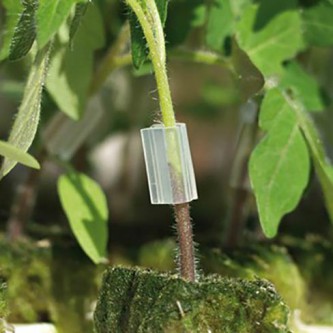Tomato rootstock Echelon can be used to grow your own rootstocks from seed on which you can graft your own tomato plants. These seeds have good germination capacity, they are also easy to use and they have very good resistance to common tomato diseases such as: tomato mosaic virus (ToMV:0-2), Fusarium (tomato wilt, Fol 0,1), tomato foot and root rot (For), Verticillium (Va/Vd), cork root (Pl), leaf spot (Ff:A-E) and powdery mildew (On). The tomatoes grafted on these rootstocks have a stronger root system, fewer leaves and produce more fruit. Thanks to this rootstock, the tomato plants have a good yield, the plants grow taller and have fewer leaves and more fruit. The fruits also grow faster than usual. Use the tomato grafting clips to attach the tomato plant to the rootstock.
Advantages of grafting are that there is a longer growing period. You can harvest bigger and more fruits because of the stronger growth. It is also possible to have two growing stems per plant. They also have a high resistance to tomato diseases. Deficiency diseases are also rare. The rootstocks are resistant to: tomato mosaic virus (ToMV:0-2), Fusarium (tomato wilt disease, Fol 0,1), tomato foot and root rot (For), Verticillium (Va/Vd), cork root (Pl), leaf spot disease (Ff:A-E) and powdery mildew (On). You can also do your own grafting, which is cheaper than buying grafted plants. When you do the grafting yourself, you can also decide which variety you want to use. Preferably use F1 rootstocks because these have all the desired resistances against diseases.
Indoor sowing: February - April
Germination temp: 20 - 25°C
Germination: 6 - 14 days
Sowing depth: 2 - 3 mm
First, sow the rootstock tomatoes in the normal way. Take small pots filled with moist potting compost. Sow 1 seed per pot superficially on the ground. Gently press the seeds. Keep the temperature as even as possible. Don't let the temperature drop at night. Place the pots in a heated chamber or propegator with a lid and heater. Also provide enough light. Once the seeds germinate, you can remove the lid. Place the tomato plants in larger pots as soon as they are large enough to handle. Now put them away a little cooler at about 18 - 20 ° C. After this you can continue to grow the rootstocks for later use.
About 14 days after sowing the rootstocks, you can graft the tomatoes onto a rootstock. This can be done quite easily yourself. After this you can prepare one of your tomato plants for grafting. You can graft tomatoes as this will increase yields and improve resistance to common tomato diseases. You can also graft to grow distinct and unique plants.
Here is an easy and simple method for grafting tomatoes. You will need an upper trunk, a rootstock, a sharp knife and a tomatograftingclip. Both plants are bound together and this also keeps the root systems connected until the wound has healed. It is important that the diameter of both stems is the same.
The rootstock and the uppertrunk must both be cut diagonally with a sharp knife. Make sure both cuts are the same depth so that the connection is firm. This connection between the two plants is enough to take advantage of the beneficial properties of the rootstock. The rootstock provides extra vigor, resistance and fruits.
Cut the rootstock at about 10 - 15 cm. Make a cut down to about half the thickness of the stem. At the top trunk this will be a cut upwards to about half the thickness of the stem. Make diagonal cuts so that the two halves can fit together better. Make the cuts the same length as well. Do not cut too far as this will cause the plant to die. Then carefully slide both parts together. Press them gently. Make sure the parts fit together properly. That ensures a better result. Work as accurately and quickly as possible.
Connect the grafting site with a special tomatograftingclip. This ensures that both parts are well connected and cannot slide. Leave the clip in place. The plant has no further problems with this. The root systems are put together in a pot. Place the grafting plant in a cool, quiet place without direct sun for about 7-10 days. E.g. in a shed, garage or indoors. After about 10 days, the adhesion is so strong that the plant can be placed in its permanent place. Stick stakes near the plant to support it. Remove the tops from the plants. This causes new shoots to grow from the axilla of the plant. These shoots will carry the tomatoes. After this, the plant can be placed in its permanent place outside (sheltered) or inside a greenhouse.









